This content has been archived. It may no longer be relevant
‘The Prime Ministers were therefore poorly advised because the section of the Kokoda Trail they spent most of their time on did not exist in 1942. They were therefore denied an emotional connection to it as there was no action in the area and no engagement with the ‘fuzzy wuzzy angels’ between Deniki and the Isurava Memorial.‘
The DFAT-PNG strategy to shield Prime Ministers’ Albanese and Marape from their failures to manage Kokoda tourism over the past 15 years was evident in their choice of a self-proclaimed ‘military historian’ to accompany them, and the route they chose.
They could hardly have used Australia’s National Military Heritage Advisor in PNG because the media entourage would surely have questioned how an American anthropologist with no qualification in military history or any previous military service got such a plum job. They would then have learned that the process used to recruit him was dodgy. DFAT PNG could therefore not afford to have this exposed so it was best for them to keep him in the back office for the duration of their trek.
If expressions of interest had been called to lead such an important entourage the following Kokoda historians should have been considered:
- Lieutenant Colonel Rowan Tracey LLB BA who has served with the PNG Defence Force, is fluent in Tok Pisin, has been trekking and studying the Kokoda campaign since the late 1980s. He served in the regular army for 21 years and is the author of the Official History of the 2nd Division AIF;
- Major Chad Sherrin MM who was awarded the Military Medal for his leadership in combat during the Vietnam War. He is a former jungle training instructor at Canungra, has trekked Kokoda 96 times over 20 years and has studied the campaign from a regular soldiers’ perspective;
- Captain Frank Taylor, former WA Police Inspector and army reservist who has also trekked Kokoda since the 1980s, and
- Captain Reg Yates who has also trekked Kokoda since the 1990s and has been visiting and recording battlesites throughout PNG since the 1980s. He wrote the ‘Army Guide to Adventure Training in PNG’.
Mr. Mark Nizette MBE, the DFAT Strategic Advisor in PNG was well aware of their credentials but would have been concerned they may have exposed the many failures of Kokoda tourism management under his watch since he was assigned from Canberra 13 years ago in 2011.
So, David Howell, owner of the Business Name ‘Kokoda Historical’, who is associated with Nizette due to his role as Secretary of the shameless Australian Kokoda Tour Operators Association was chosen despite the fact he has operated illegally in PNG for most of the time since he first started leading treks in 2006.
Prime Minister Marape inadvertently ‘belled the cat’ on the integrity of their trek when he advised Governor Gary Juffa would be assisting with its operation.
Juffa is the mixed-race Governor of Oro Province – a gifted orator who conveniently downplays his Irish ancestry to take on the guise of an Orokaiva leader.
Juffa’s words, however, are rarely matched by action – back in 2013 he boasted he had a plan for Kokoda – but like most of Juffa’s boasts which have earned him the nickname ‘distant thunder’ – nothing ever happened!
From: juffa@theeducatedsavage.com
To: Warren Bartlett sogent@sogerilodge.com
cc. juffa@theeducatedsavage.com; ‘Charlie Lynn’ <charlie@charlielynn.com.au>; Charlie Lynn charlie@kokodatreks.com.au
Date: Sat 27/04/2013 7:00 AM
Hi Warren and Charlie, thank you for the information. I shall most certainly be keen to release.
IN regards to the media release, there is only one minor but important detail: my grandfather was a soldier in the PIB.
Great meeting you Charlie and hope to see you gentlemen more often in time to come.
I have plans to improve Kokoda and make it a memorable station worthy of its great history.
I have a keen interest in reviving the other areas of historic significance as well such as Buna and Sananda, Oivi and Wairope and others.
You gentlemen could greatly assist with research and data that would assist me.
Regards,
Gary
Nothing, absolutely nothing, has been done to enhance the wartime tourism value of the Kokoda plateau since Juffa was elected Gpvernor in 2012!
The only ‘museum’ and monuments on the plateau were built privately by the Kienzle family.
The potential of building a commemorative centre in the vicinity of the old wartime administrative building (all that remains of it are the concrete steps) with a cultural performance area where the Australian flag was raised in 1942, along with a cultural archway onto the plateau, has been consistently ignored by Juffa and the DFAT Kokoda Initiative.
After exiting the plateau Juffa would have led them through the unsightly steel girders forming what is now known as ‘the McArches’, an unofficial and inappropriate structure in the wrong location, and onto Deniki.
It’s not known how he would have explained the lack of ablution facilities at the Deniki campsite – or why the DFAT Kokoda Initiative has failed to invest in a single hygienic toilet for trekkers anywhere along the 138 km Trail since they took control of it 15 years ago.
It’s also likely that Juffa didn’t realise he was leading the Prime Minister’s entourage off the wartime Trail after they left Deniki.
The route he took followed the post-war track through long abandoned cattle yard sites which are now overgrown with choko vines planted after the war by Captain Bert Kienzle’s wife, Meryl Holliday, a former opera singer and nurse he had courted while on leave in Sydney in 1935.
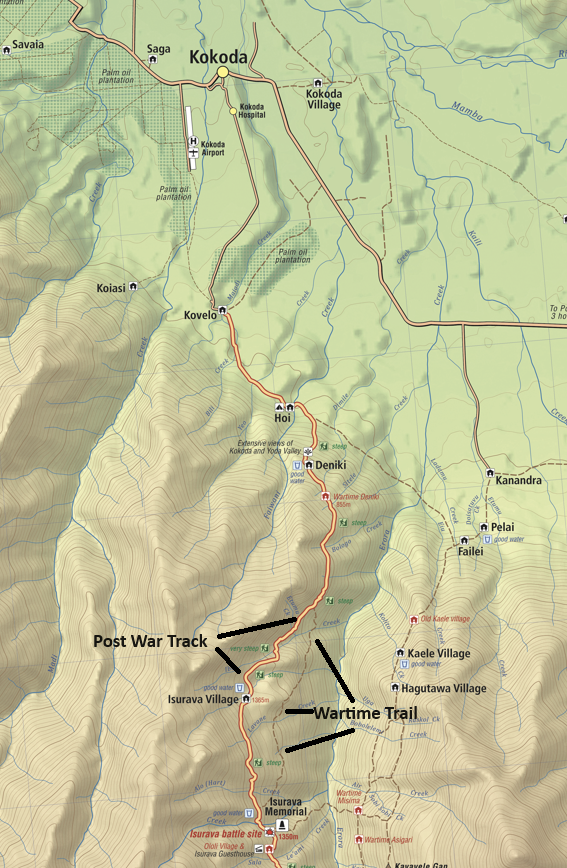
Kokoda to Isurava Memorial: 19.6 km – Total Climb 1220 metres. Total Descent: 310 metres
Bert’s son, Soc Kienzle, remembers the method they used to carry calves tied to stretchers beyond Deniki on the current track to the cattle yards.
It is also not known if Juffa advised them that wartime carriers, the famous ‘fuzzy-wuzzy angels’ did not operate along this section of the Trail during the campaign. The entourage therefore missed the opportunity to capture the emotion of their sacrifice.
We can only wonder why DFAT PNG did not engage Soc Kienzle as a historical advisor for the entourage as he is the most knowledgeable expert on the post-war history of the area. His wife Robyn is the author of ‘The Architect of Kokoda’ which tells the remarkable story of Captain Bert Kienzle and his role in the command and control of thousands of wartime carriers across the Trail during the campaign. The book would have been a meaningful gift to each member of the entourage at the end of their trek.
Soc would have advised them of the location of the junction of the wartime trail with today’s track via the village of Isurava which relocated to the current site after the war.
The original wartime trail runs parallel to today’s track further down the valley and bypasses the village of Isurava. It is therefore doubtful if Governor Juffa was aware that the entourage he was leading spent most of their day off the original wartime Trail and on the post-war track via Isurava village before merging with the original Trail just before Front Creek at the Isurava battlesite and memorial.
Both Prime Ministers were therefore poorly advised because the section of the Kokoda Trail they spent most of their time on did not exist in 1942. They were therefore denied an emotional connection to it as there was no action in the area and no engagement with the ‘fuzzy wuzzy angels’ between Deniki and the Isurava Memorial.
However, it would have been a different story if they had been properly advised and trekked north from Templeton’s Crossing, via Eora Creek, to the Isurava Memorial.
The stories along this section cover one of the most heroic fighting withdrawals during the war in Papua and New Guinea and the later attacks from Templeton’s Crossing through to Eora Creek. An area that would have taken them perhaps half a day to trek through took 13 days for the Australians to fight through and another four days to finally capture the Eora Creek position.
This route, which is almost four kilometres shorter than the one they took from Kokoda to the Isurava Memorial, is littered with stories of endurance, courage, sacrifice and mateship and would have made their arrival at Isurava much more meaningful. While the terrain is more rugged in nature it is not as steep and includes the spectacular (but safe) crossing over the raging waters of Eora Creek.
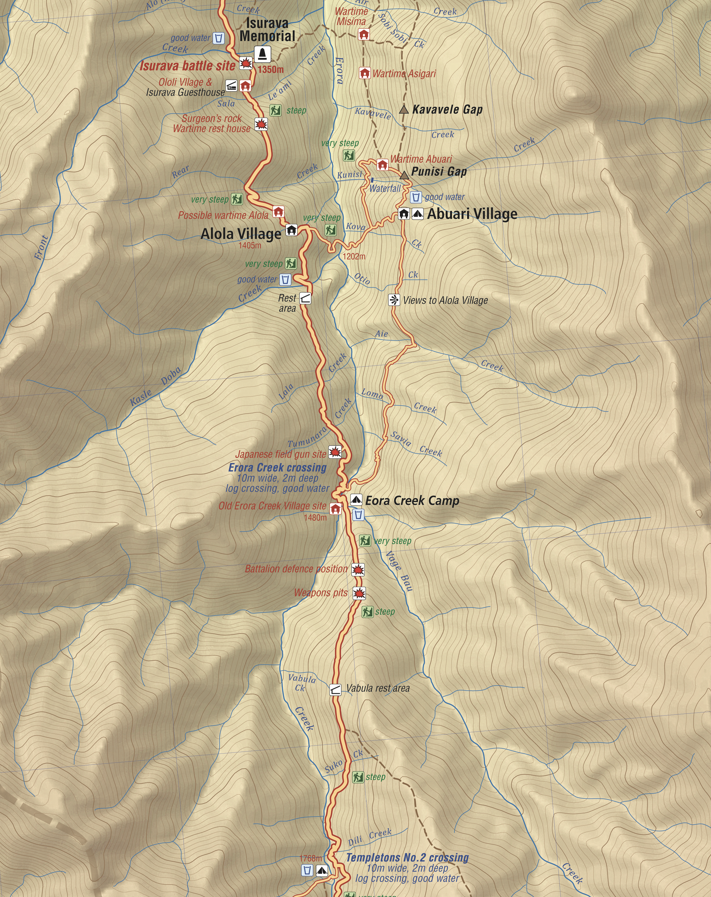
Templelton’s Crossing to Isurava Memorial – 16.2 kilometres. Total climb-1962 metres. Total Descent – 752 metres
Wartime journalist, Osmar White captured the desperation of young soldiers fighting to stave of the fanatical Japanese advance at Eora Creek when they were at their most vulnerable in the dark, the rain and the mud after being driven out of Isurava:
‘At Eora I saw a 20 year old redheaded boy with shrapnel in his stomach. He kept muttering to himself about not being able to see the blasted Japs. When Eora was to be evacuated, he knew he had very little chance of being shifted back up the line. He called to me, confidentially: “Hey dig, bend down a minute. Listen … I think us blokes are going to be left when they pull out. Will you do us a favour? Scrounge us a tommy gun from somewhere will you?”
‘It was not bravado. You could see that by looking in his eyes. He just wanted to see a Jap before he died. That was all. Such things should have been appalling. They were not appalling. One accepted them calmly. This was jungle war – the most merciless war of all.
‘I was convinced for all time of the dignity and nobility of common men.
‘I was convinced for all time that common men have a pure and shining courage when they fight for what they believe to be a just and shining cause.‘That which was fine in these men outweighed and made trivial all that was horrible in their plight.
‘I cannot explain it except to say that they were at all times cheerful and helped one another. They never gave up the fight. They never admitted defeat. They never asked for help.
‘I felt proud to be of their race and cause, bitterly ashamed to be so nagged by the trivial ills of my own flesh. I wondered if all men, when they had endured so much that exhausted nerves would no longer give response, were creatures of the spirit, eternal and indestructible as stars.’
They missed one of the finest tributes ever to the gallantry of our Kokoda troops.
Both Prime Ministers and their media entourage would have also noted that the only marker to this historic site is place is a small, bronze plaque. There is nothing to interpret either the fighting withdrawal or the later attack that led to the Japanese finally being driven off the Trail and across the Kumusi River.
If they had questioned why the DFAT Kokoda Initiative has not developed a memorial plan for a site of such significance they would have learned DFAT PNG has diverted their resources to the research of a ‘Lost Battlefield’ that does not exist – an aid-funded folly that was never a ‘battlefield‘ and has never been ‘lost’!
Heads would surely have rolled in Port Moresby if this had been brought to the Prime Ministers’ attention however DFAT PNG dodged a bullet by arranging for them to spend most of their time off the original Trail between Deniki and Isurava.
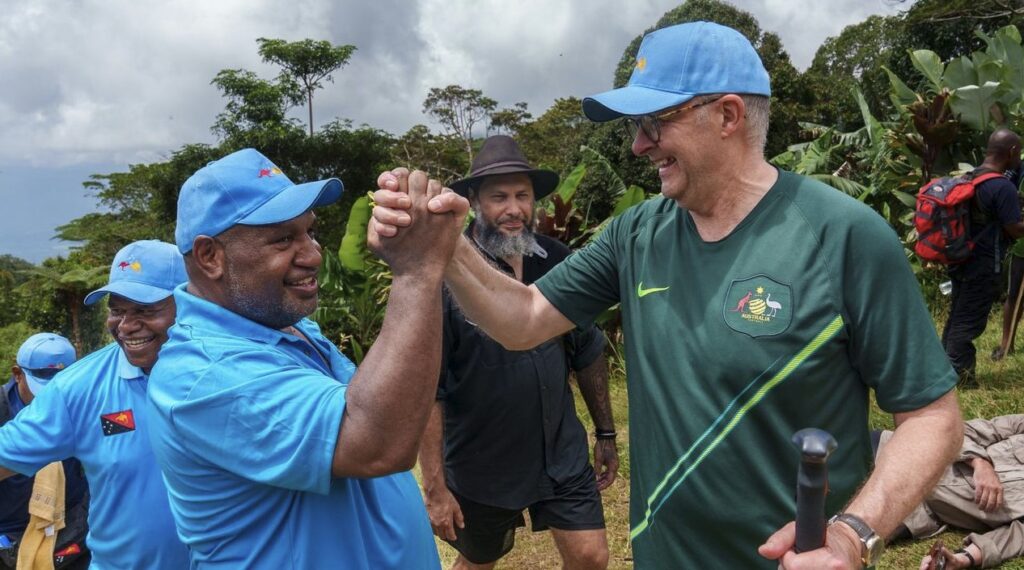
Warm greeting from Prime Minister Marape to Albo on arrival at Kokoda
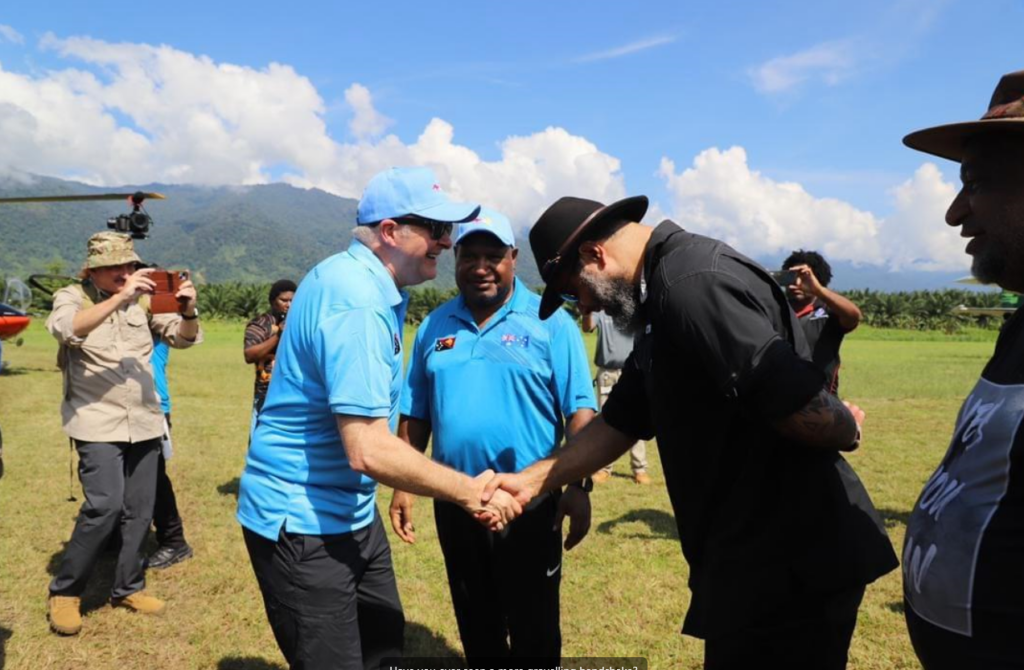
Oro Governor Juffa curtseys before Albo on arrival at Kokoda
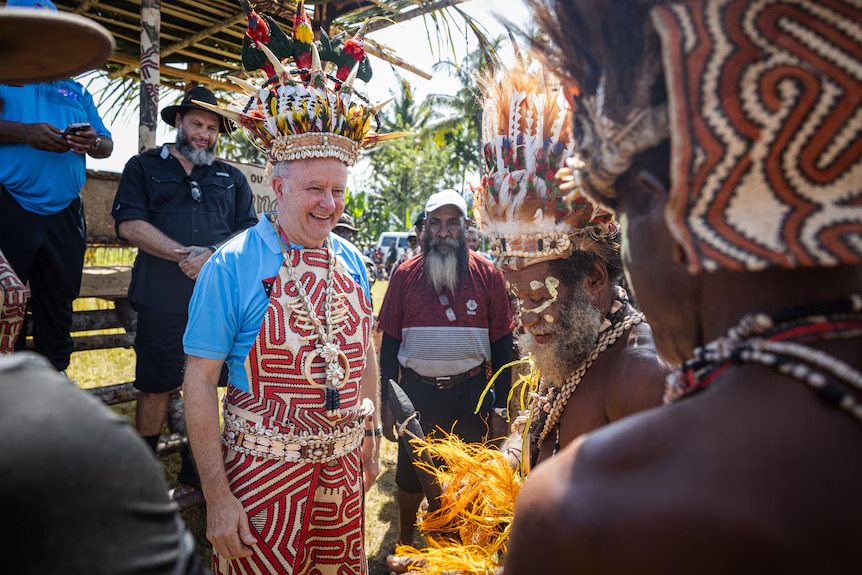
Traditional Orokaiva welcome for Albo on arrival at Kokoda
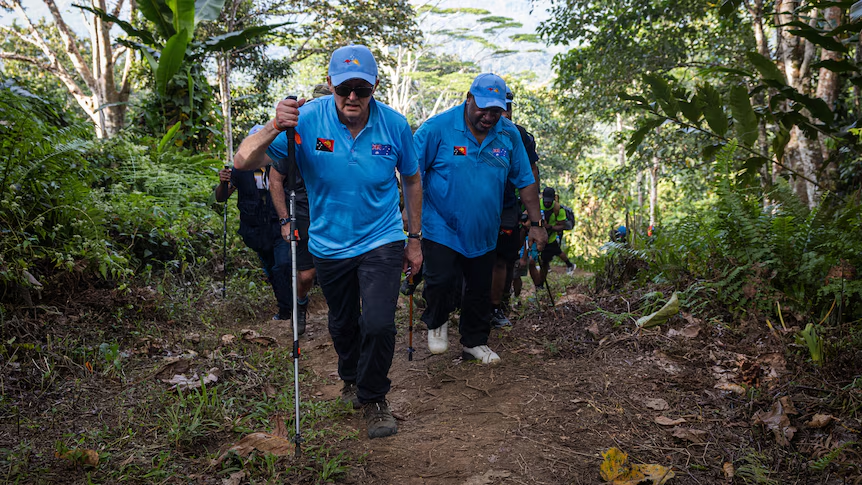
Prime Ministers Marape and Albanese leading off on their Kokoda Trek
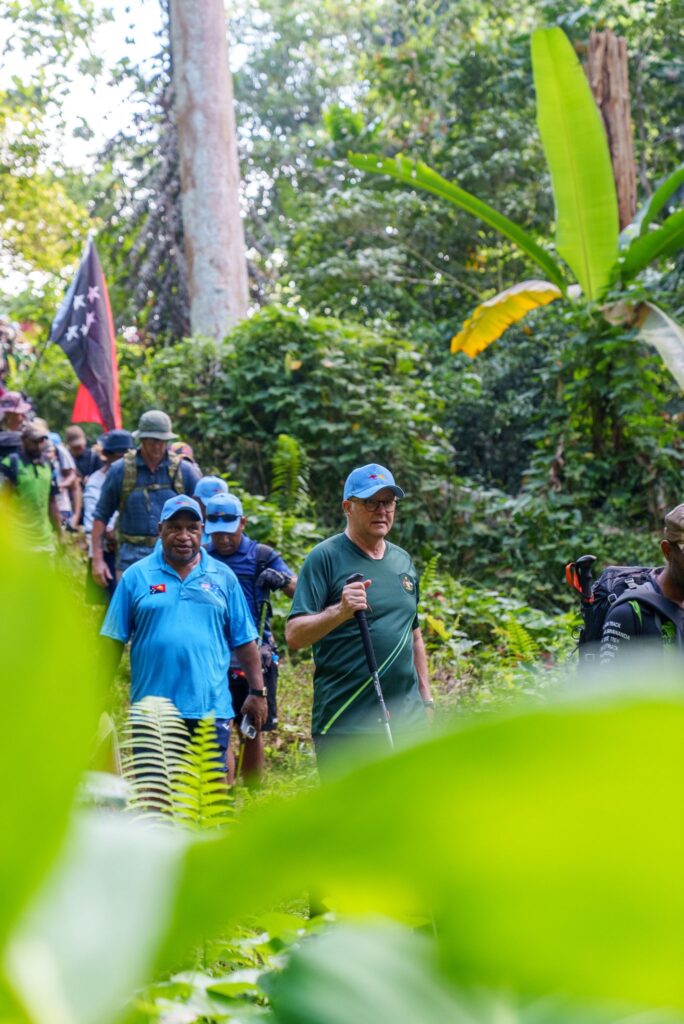
Prime Ministers’ Marape and Albanese on the post-war trek through old cattle yards covered in choko vines
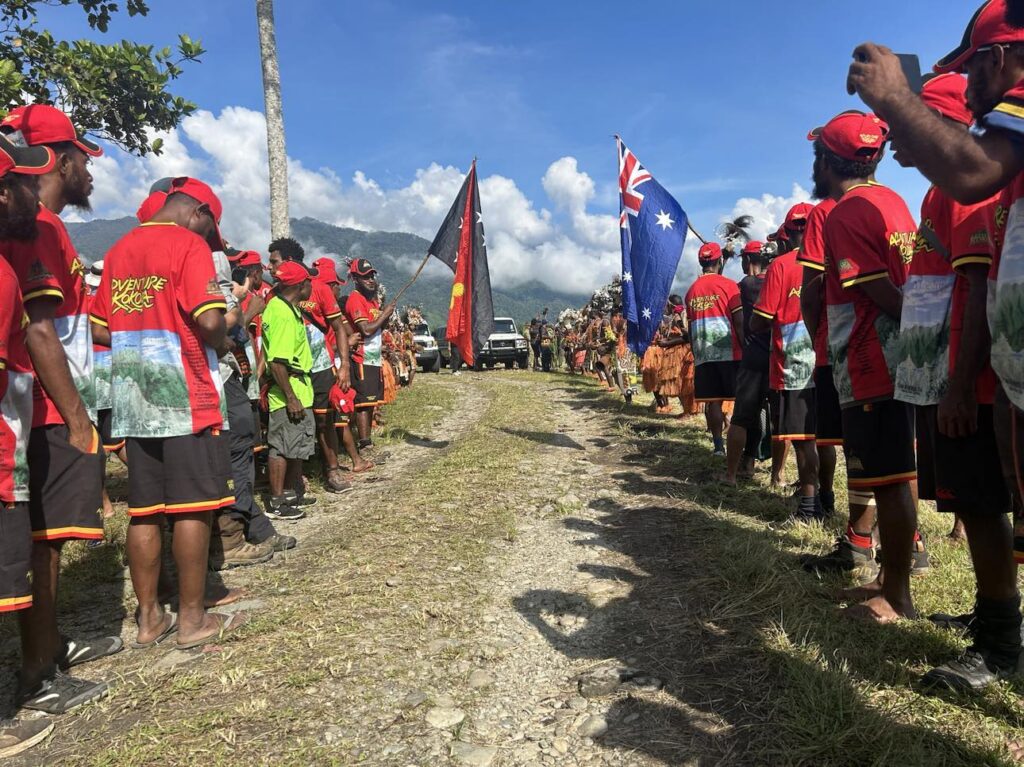
Adventure Kokoda guides and porters forming a guard of honour for Prime Ministers’ Marape and Albanese at Kokoda
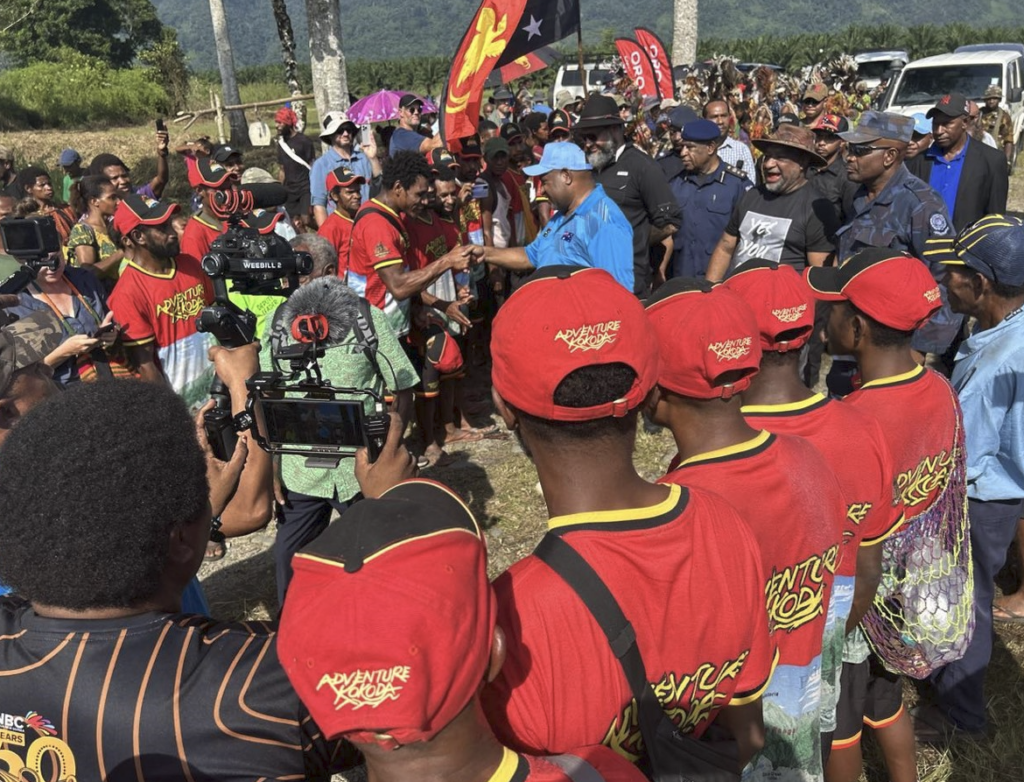
Prime Minister Marape greeting our Adventure Kokoda guides and porters at Kokoda
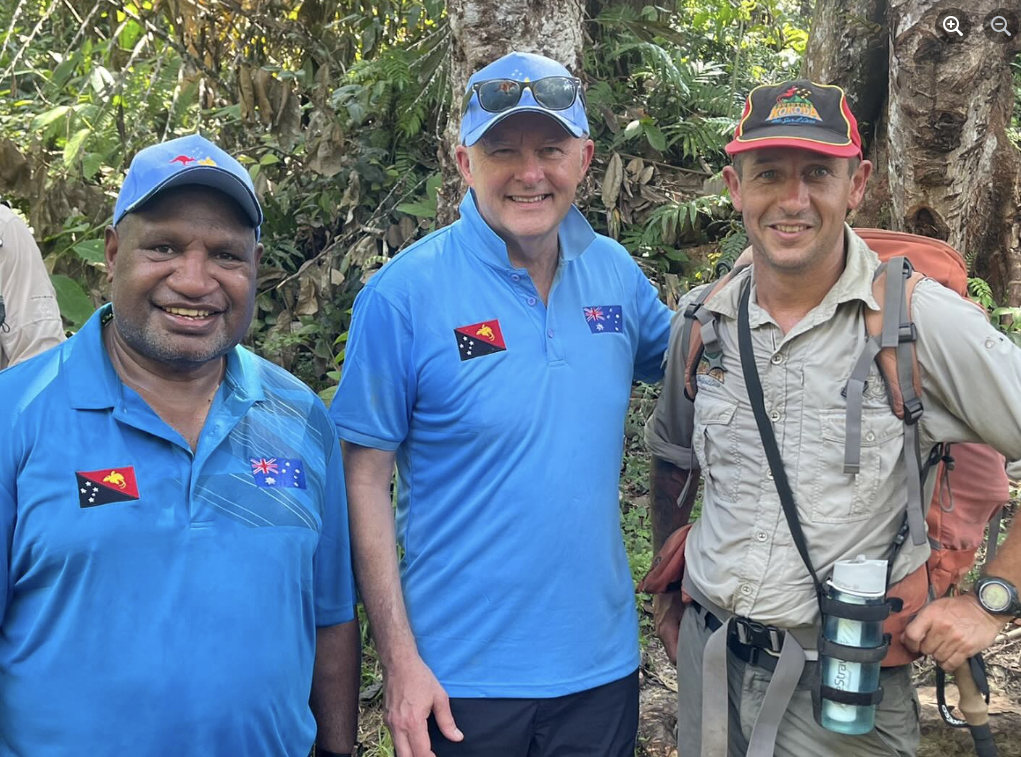
Prime Ministers’ James Marape and Anthony Albanese with Adventure Kokoda Trek Leader, Peter Morrison at Deniki


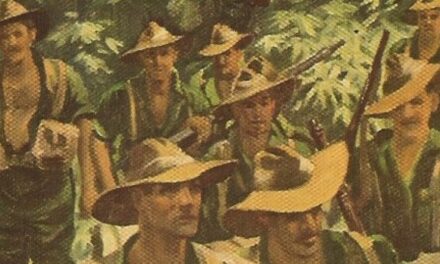
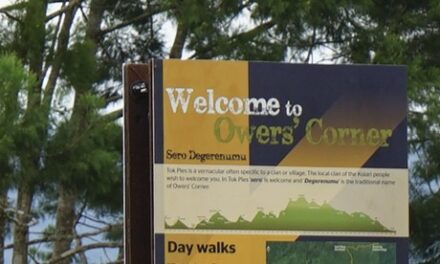
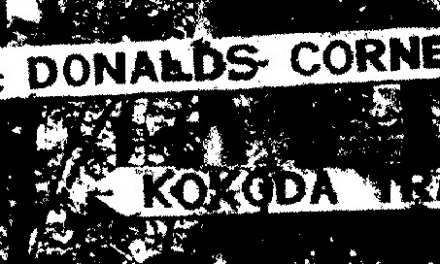

Someone’s got his knickers in a knot!!!
I’m sure that the best job that could be done was and the health of all concerned would have been taken into consideration.
The goal was to be at Isurava for ANZAC DAY dawn and to visit Kokoda.
I’m sure all concerned were more than happy with the results of the two days walking and the many others who happened to join them at dawn left everyone, except some, with a warm feeling of achievement and National pride.
You can please most of the people some of the time and some of the people most of the time but you can’t please all of the people all of the time.
I’m sure that the two Prime Ministers will remember the time they had together and what they achieved together with fondness without worrying about the historical minutiae interfering with their relationship.
PNG’s history is over 60,000 years not just 4.
You should know well what to expect when dealing with PNG!!!
Great read that gave an incredible insight of all the murmurs PNG tourism often hears of the ill treatment a of the custodians all along the track and surrounding areas.
This is one article I will share with my group – Iconic Frontier – Women in Tourism
Thanks Charlie
Sorry mate.
This had all the hallmarks of a political stunt – most likely a distraction from the blowback his government has received from Penny Wong’s recognition of a Palestinian state.
If the Prime Minister was dinkum in his desire to honour our fallen he would have attended the official Dawn Service at Bomana War Cemetery – not an unofficial one at Isurava.
If he had wanted to get an authentic taste of Kokoda he would have trekked across the wartime Trail between Templeton’s Crossing and Isurava – not the post-war track between Deniki and Isurava.
And if wanted to leave a legacy he would have announced:
1. The engagement of the Australian War Memorial to develop a Military Heritage Master Plan for the Kokoda Trail.
2. The development of a Joint Agreement to commemorate our shared wartime heritage with PNG;
3. The proclamation of ‘Kokoda Day’ as a national day of commemoration.
He did none of these so I can only assume he used ‘Kokoda’ as a prop for a political distraction.
As for ‘knowing what to expect when dealing with PNG’ it is not known as the ‘land of the unexpected’ for nothing!